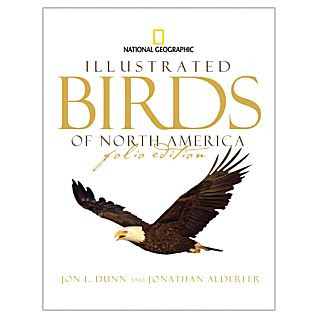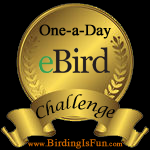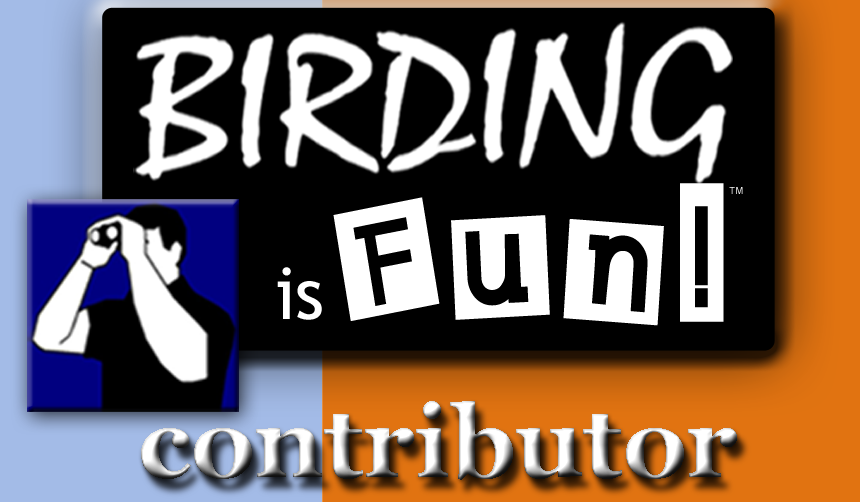
Americans have enjoyed large format bird art books since Audubon came out with his huge double-elephant folio sized The Birds of America starting in 1827. Most of us don't own anything that large, but many of us own Audubon's folio-sized reprint volumes that have almost always been in print since then. After Audubon, Louis Agassiz Fuertes and others have given us additional bird portraits, though after the success of Roger Tory Peterson's books, bird illustrations from field guides have become perhaps the most popularly viewed bird art in North America.
The worlds of bird art as illustration and bird art as portrait have finally come together again in the release of the
National Geographic Illustrated Birds of North America, Folio Edition. This book is essentially a large-format hard-cover version of the latest 5th edition of the popular National Geographic field guide. National Geographic bills it as "both hard-working reference and sumptuous art book" that "schowcases the more than 4,000 original, full-color, meticulously rendered bird paintings--by 20 contemporary bird artists--in striking detail and scientific accuracy."
So, is this really a "magnificent and highly collectible" bird art book, or just an attempt to sell us a Biggest Field Guide Ever version of the book we already have in our backpacks or on the seat of our car?
For me, I actually agree with the marketing description of this book and enjoy it as both reference and art book. First most intermediate or more advanced birders, who don't carry field guides in the field anyway, so-called field guides are really mostly desk references anyway. So the size of this book doesn't detract from its use in that way. In addition, after buying multiple copies of previous editions of the National Geographic guide, I was slow to consider even picking up the latest 5th edition. Sure there were some nice changes, but if you have a couple previous editions of this book first published in 1983, there's little incentive to go out and add the latest edition to the line up on your field guide shelf. So while I passed on the original 5th edition NGS guide, when this version came along it offered something new.
That something new is a whole new appreciation for the heft of this book. We've been spoiled over the years in seeing thousands upon thousands of bird field guide illustrations and hundreds of thousands of bird photographs. Increasing the size of this book helps us appreciate just what a monumental book it really is and has been since the 1980s. Think about it--over 4,000 original bird paintings. We used to just carry that around in our large coat pocket and not think much more about the paintings except for their use-value in helping us identify birds. While we would never use original Audubon prints for dinner table placemats, we've been undervaluing the artwork of the NGS guide by treating it as mere illustrations for helping us answer our mundane bird identification questions.
But no more. When you hold the National Geographic Illustrated Birds of North America, Folio Edition in your lap, the sheer weight of the book shatters that mindset. As you leaf through the pages of this volume, you start to see the illustrations for what they are--amazing and "meticulously rendered bird paintings...in striking detail and scientific accuracy."
I'll admit that when I first heard of this project, I had my doubts. While the text and illustrations of the original NGS field guide sent shockwaves through birding communities and immediately replaced the Peterson and Golden Guides as the guide of choice when it came out in the 80s, I thought that some of the illustrations had become a bit stale in the intervening years. For example I had never really warmed to Donald Malick's Great Horned Owl plate (p.257) and H. Douglas Pratt's jay plate (p.321) had grown a bit stale after more than 25 years of exposure.
Happily, even these plates take on new life in the larger format. As field guide illustrations, they may have lacked a certain spark, but as bird portraits, they unquestionably rank with the works of previous grand masters. They may never be my favorites, but seeing them closer to how they were originally painted, rather than scrunched into a more compact format, seems to release them from bondage and bring them alive again.
So the art work is wonderful, and it is a joy to peruse the plates as art rather than mere illustration.
That said, here's what I'd like to see in a second edition of this book:
1) There's a lot more room here, so perhaps we could expand the text of the species accounts a bit? Give us a little extra something that wouldn't fit in the original smaller format guide?
2) Since this version is billed as an art book as much as a field guide, how about printing the signatures of the artists on each plate so we can appreciate them without having to search out the credits in the back of the book.
3) If we left the species accounts as they are, how about giving us a section at the bottom of each text page with notes on the art from the original artists? Sort of like the director's commentary on a DVD? I'd love to have more info on what went into painting each of these 4,000+ masterpieces.
But even without these extra features, the National Geographic Illustrated Birds of North America, Folio Edition deserves a place in the house where it will be picked up and enjoyed--and not just a space on the shelf next to your similarly-sized Audubon reprint. For a North American field guide, the text of the 5th edition reproduced here is still a fantastic and valuable reference, and the artwork is worth seeing and lingering over in this larger format. It isn't just the Biggest Field Guide Ever, this book is something more. If nothing else, the artists who's illustrations have helped us identify birds for so many years, deserve for us to appreciate their works as the first-rate bird portraits that they truly are.
 I've already come up with my best birds of the 2000s, but here's my quick list of my best birds of 2009:
I've already come up with my best birds of the 2000s, but here's my quick list of my best birds of 2009:
















































